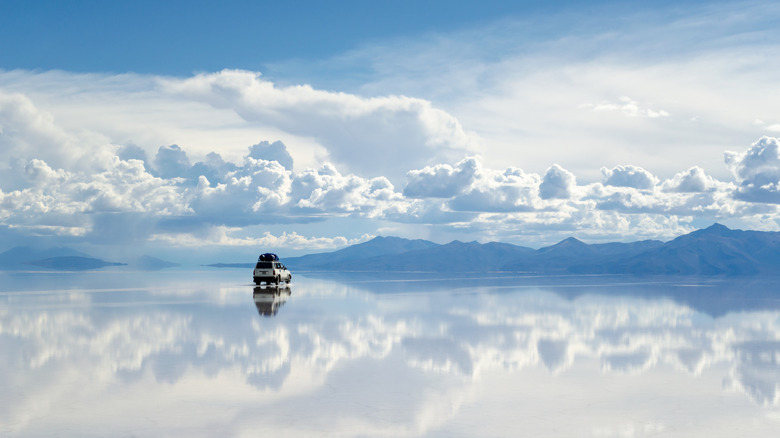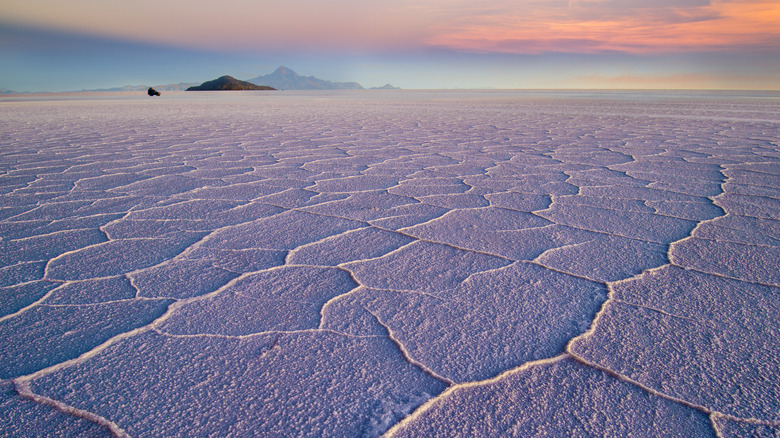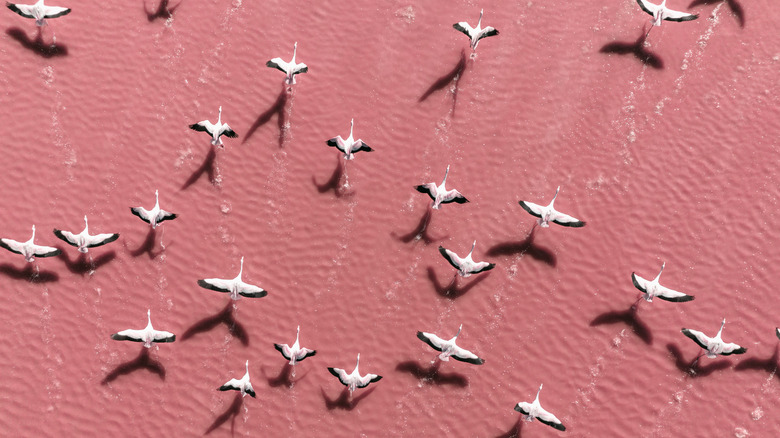The World's Largest Natural 'Mirror' Is A Surreal Landscape Of Water, Salt And Sky In South America
The salt flats of Bolivia's Salar de Uyuni make up one of the most mesmerizing and otherworldly landscapes on the planet. They are also one of the mysterious places around the globe that leave visitors with more questions than answers. Covering an area of over 4,000-square-miles in the country's southwest, the flats sit at an altitude of 12,000 feet, a vast, white expanse formed by the evaporation of ancient lakes whose remains constitute a sprawling crust of hexagonal salt formations that are more than 30-feet deep in some places.
But what really makes Salar de Uyuni remarkable is what happens when rainwater causes nearby bodies of water to overflow and empty into the basin — they form a shallow, temporary lake that, due to the flats' lack of topographic variation, turns it into the world's largest reflective surface. These transient pools often feature such clarity that it can be difficult to tell where the Earth ends and the sky begins. Because of its alluring, almost alien beauty, Salar de Uyuni is a tempting draw for outdoor lovers, adventurers, and photographers alike.
The salt flats are more than just a pretty postcard, however. The area features some fantastically unique attractions, like the Isla Incahausi, a cactus-covered "island" rising amidst the sea of salt that offers visitors incredible views of the surrounding landscape. Wildlife lovers will find the roving bands of pink flamingos, which gather in the shallow waters to rest during the migratory journey through the region, particularly enchanting. Travelers looking to put Salar de Uyuni on their itineraries shouldn't hesitate. The flats contain massive lithium reserves, whose presence has put the Bolivian government in an uncomfortable position as it tries to balance tourism, conservation, and strong economic incentives to mine the valuable material, worrying some that the future of the flats could be in question.
When to visit Salar de Uyuni and what to see
For those planning a visit to the salt flats, timing is key. To see the mirror effect in its full glory, the best time to arrange a trip is during the wet season, which ranges from December to April. Be aware that too much rainfall can and does lead to tour cancellations, however. But if you prefer to see the Salar de Uyuni in its hexagonal-shaped, salt-encrusted clothing, aim for the dry season (May to November), which is also going to give you the best shot at clear views of the horizon and the sky, which is no small thing as the area is a fantastic spot for stargazing.
Beyond marveling at the flats themselves, visitors can explore the unique attractions in and around Salar de Uyuni. Isla Incahuasi is an island covered in towering cacti that is great for panoramic views of the flats. Often inaccessible during the wet season, the island features a trail that leads hikers on a 15-minute walk to the top and even a cafe-restaurant perfect for a lunch break. Wildlife enthusiasts will want to keep their eyes peeled for the Southern Viscacha, a rabbit-like rodent that sticks to the shade of the massive Trichocereus cactus, a high-altitude plant found in the Andes that can grow up to 20-feet tall.
A more peculiar destination in the area is the Cementerio de Trenes — the Train Graveyard. This site sits just outside of the town of Uyuni and is littered with the dramatic, rusted-out remains of Bolivia's railway heyday. The late 19th century saw Uyuni become a mining transport hub whose 1940s collapse resulted in the trains being abandoned and stripped for parts. The graveyard remains a great spot for grabbing some surreal photographs before heading out to the salt flats themselves.
Unforgettable places to stay around Salar de Uyuni
Fittingly, accommodation options in the area around Salar de Uyuni are often as unique as the salt flats themselves. Foremost among these are the renowned salt hotels, where nearly everything, from walls to furniture, is crafted from salt blocks. Palacio de Sal, near the town of Colchani, is one of the most famous and was constructed from a million blocks of compressed salt bricks. The hotel features salt sculptures throughout the grounds and an exposed "salt wall" where visitors can better see how the structure was built. Luna Salada Hotel is another standout, being perched on the edge of the salt flats and offering some stellar views of the vast white plains.
While the flats are mesmerizing, they make up just a portion of the Altiplano area, the plateau that reaches across parts of Peru, Bolivia, Chile, and Argentina. In its Bolivian portion, travelers can explore the Eduardo Avaroa Andean Fauna National Reserve, home to the stunning Laguna Colorada (Red Lagoon) and Laguna Verde (Green Lagoon). Laguna Colorada's waters exhibit a reddish hue due to the zooplankton and phytoplankton that live there. Roughly 30,000 flamingos call the lagoon home. Laguna Verde, on the other hand, is lifeless, its waters replete with high magnesium, calcium, and arsenic levels. Regardless, the green water, which varies from shades of turquoise to deep emerald on any given day, makes for an excellent photo opportunity.
All told, Salar de Uyuni and its surrounding environment are clear reasons why Bolivia is on our ultimate bucket list for a trip to South America. If you're interested in learning more about other travel gems on the continent, check out the South American destination that's an overlooked lakeside getaway.


